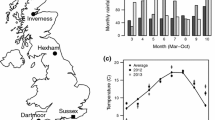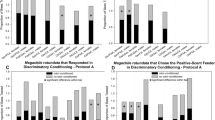Abstract
Recognition of kin in sweat bees is dependent upon social learning. Shortly after emergence as adults, bees learn the odors of nestmates, normally relatives, and use this knowledge to keep nonnestmate (and therefore nonkin) bees out. The odors are heritable so that once a bee learns the odors of its kin, it can recognize other kin that it has never met before. An individual guard bee does not seem to use knowledge of self as a reference. Larval learning of odors, common rearing of offspring, maternal inheritance, and inbreeding effects are not sufficient to explain the recognition of unfamiliar relatives. Individual guard bees can discriminate between close and distant relatives. Kin recognition may be a secondary or serendipitous use of odors that originally evolved for the recognition of mates and nest entrances.
Similar content being viewed by others
References
Alexander, R. D. (1979).Darwinism and Human Affairs, University of Washington Press, Seattle.
Barrows, E. M. (1975a). Individually distinctive odors in an invertebrate.Behav. Biol. 15:57–64.
Barrows, E. M. (1975b).Mating Behavior in Halictine Bees, Ph.D. dissertation, University of Kansas, Lawrence.
Barrows, E. M. (1975c). Mating behavior in halictine bees (Hymenoptera: Halictidae). III. Copulatory behavior and olfactory communication.Insectes Soc. 22:307–331.
Batra, S. W. T. (1964). Behavior of the social bee,Lasiglossum zephyrum, within the nest (Hymenoptera: Halictidae).Insectes Soc. 11:159–185.
Batra, S. W. T. (1966). The life cycle and behavior of the primitively social bee,Lasioglossum zephyrum (Halictidae).Univ. Kans. Sci. Bull. 46:359–423.
Bell, W. J. (1974). Recognition of resident and non-resident individuals in intraspecific nest defense of a primitively eusocial halictine bee.J. Comp. Physiol. 93:195–202.
Bell, W. J., and Hawkins, W. A. (1974). Patterns of intraspecific agonistic interactions involved in nest defense of a primitively eusocial halictine bee.J. Comp. Physiol. 93:183–193.
Bennett, B. (1987). Measures of relatedness.Ethology 74:219–236.
Blaustein, A. R., and O'Hara, R. K. (1986). Kin recognition in tadpoles.Sci. Am. 254:108–116.
Breed, M. D., Silvermam, J. M., and Bell, W. J. (1978). Agonistic behavior, social interactions, and behavioral specialization in a primitively eusocial bee.Insectes Soc. 26:351–364.
Buckle, G. R., and Greenberg, L. (1981). Nestmate recognition in sweat bees (Lasioglossum zephyrum): Does an individual recognize its own odour or only odours of its nestmates?Anim. Behav. 29:802–809.
Crozier, R. H., Smith, B. H., and Crozier, Y. C. (1987). Relatedness and population structure of the primitively eusocial beeLasioglossum zephyrum (Hymenoptera: Halictidae) in Kansas.Evolution 41:902–910.
Fletcher, D. J. C., and Michener, C. D. (1987).Kin Recognition in Animals, John Wiley & Sons, Chichester.
Gamboa, G. J., Reeve, H. K., and Pfennig, D. W. (1986). The evolution and ontogeny of nestmate recognition in social wasps.Ann. Rev. Entomol. 31:431–435.
Getz, W. M. (1982). An analysis of learned kin recognition in Hymenoptera.J. Theor. Biol. 99:585–597.
Greenberg, L. (1979). Genetic component of bee odor in kin recognition.Science 206:1095–1097.
Greenberg, L. (1981).The Function of Heritable Odors in Kin and Nestmate Recognition in a Sweat Bee, Lasioglossum zephyrum, Ph.D. dissertation, University of Kansas, Lawrence.
Greenberg, L. (1982). Persistent habituation to female odor by male sweat bees (Lasioglossum zephyrum).J. Kans. Entomol. Soc. 55:525–531.
Hamilton, W. D. (1972). Altruism and related phenomena, mainly in social insects.Annu. Rev. Ecol. Syst. 3:193–232.
Hölldobler, B., and Michener, C. D. (1980). Mechanisms of identification and discrimination in social Hymenoptera. In Markl, H. (ed.),Evolution of Social Behavior: Hypotheses and Empirical Tests, Dahlem Konferenzen, Verlag Chemie, Weinheim and Deerfield Beach, Fla., pp. 35–58.
Kukuk, P. F. (1985). Evidence for an antiaphrodisiac in the sweat beeLasioglossum zephyrum.Science 227:656–657.
Kukuk, P. F., and Decelles, P. (1986). Behavioral evidence of population structure inLasioglossum zephyrum (Hymenoptera: Halictidae): Female dispersion patterns.Behav. Ecol. Sociobiol. 19:233–239.
Kukuk, P. F., Breed, M. D., Sobti, A., and Bell, W. J. (1977). The contribution of kinship and conditioning to nest recognition and colony member recognition in a primitively eusocial bee,Lasioglossum zephyrum (Hymenoptera: Halictidae).Behav. Ecol. Sociobiol. 2:319–327.
Michener, C. D., and Smith, B. H. (1987). Kin recognition in primitively eusocial insects. In Michener, C. D., and Fletcher, D. J. C. (eds.),Kin Recognition in Animals, John Wiley & Sons, Chichester.
Sherman, P. W., and Holmes, W. G. (1985). Kin recognition: Issues and evidence.Fortsch. Zool. 31:437–460.
Smith, B. H. (1983). Recognition of female kin by male bees through olfactory signals.Proc. Natl. Acad. Sci. USA 80:4551–4553.
Smith, B. H. (1987). Effects of genealogical relationship and colony age on the dominance hierarchy in the primitively eusocial beeLasioglossum zephyrum.Anim. Behav. 35:211–217.
Smith, B. H., Carlson, R. G., and Frazier, J. (1985). Identification and bioassay of macrocyclic lactone sex pheromone of the halictine bee,Lasioglossum zephyrum.J. Chemical Ecology 11:1447–1456.
Sokal, R. A., and Rohlf, F. J. (1969).Biometry, W. H. Freeman, New York.
Wcislo, W. T. (1987). The role of learning in the mating biology of a sweat beeLasioglossum zephyrum (Hymenoptera: Halictidae).Behav. Ecol. Sociobiol. 20:179–185.
Author information
Authors and Affiliations
Additional information
This work was supported by NSF Grant BNS 82-00651 (C. D. Michener, principal investigator).
Rights and permissions
About this article
Cite this article
Greenberg, L. Kin recognition in the sweat bee,Lasioglossum zephyrum . Behav Genet 18, 425–438 (1988). https://doi.org/10.1007/BF01065512
Issue Date:
DOI: https://doi.org/10.1007/BF01065512




